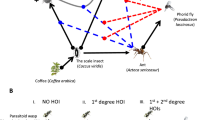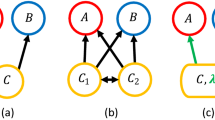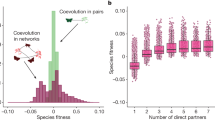Abstract
It is widely believed that when populations of two species of animals compete, each has an adverse effect on the other1,2. In other words, each zero growth isocline (dNi/dt = 0 where Ni is the population density of species i) is assumed to be some negative function of the population density of the other species. Cases where one species has a marked effect on the other, but there is no detectable reciprocal effect are sometimes distinguished as ‘amensalism’2,3. This is regarded as unusual. Standard textbooks of ecology either do not mention it1,4–6, define it but do not discuss it2, or occasionally give a brief account3. Ricklefs7 states that “competition can manifest itself by reducing the numbers of one or both competing species” without saying which is the more usual. Here we show that for insects in natural conditions, strongly asymmetrical competition (amensalism or near amensalism) is the norm rather than the exception by a ratio of at least 2:1.
This is a preview of subscription content, access via your institution
Access options
Subscribe to this journal
Receive 51 print issues and online access
$199.00 per year
only $3.90 per issue
Buy this article
- Purchase on Springer Link
- Instant access to full article PDF
Prices may be subject to local taxes which are calculated during checkout
Similar content being viewed by others
References
Krebs, C. J. Ecology. The Experimental Analysis of Distribution and Abundance (Harper & Row, New York, 1978).
Odum, E. P. Fundamentals of Ecology (Saunders, Philadelphia, 1971).
Williamson, M. The Analysis of Biological Populations (Edward Arnold, London, 1972).
Colinvaux, P. A. Introduction to Ecology (Wiley, New York, 1973).
Collier, B. D., Cox, G. W., Johnson, A. W. & Miller, P. C. Dynamic Ecology (Prentice-Hall, London, 1974).
Whittaker, R. H. Communities and Ecosystems (Macmillan, New York, 1975).
Ricklefs, R. E. Ecology (Thomas Nelson, London, 1973).
Cody, M. L. & Diamond, J. M. (eds) Ecology and Evolution of Communities (Belknap, Cambridge, Massachusetts, 1975).
Hutchinson, G. A. An Introduction to Population Ecology (Yale University Press, Cambridge, Massachusetts, 1975).
Mound, L. A. & Waloff, N. (eds) Diversity of Insect Faunas (Blackwell, Oxford, 1978).
Lawton, J. H. & Hassell, M. P. in Ecological Entomology (ed. Huff aker, C. B.) (in the press).
Lawton, J. H. & Strong, D. R. Jr Am. Nat. 117 (in the press).
Pontin, A. J. J. Anim. Ecol. 38, 747–754 (1969).
Force, D. C. Science 184, 624–632 (1974).
Stiling, P. D. J. Anim. Ecol. 49, 793–805 (1980).
Inouye, D. W. Ecology 59, 672–678 (1978).
Pajunen, V. I. Ann. Zool. Fenn. 16, 195–200 (1979).
Zwolfer, H. Fortschr. Zool. 25, 331–353 (1979).
McClure, M. S. & Price, P. W. Ecology 56, 1385–1397 (1975).
Istock, C. A. Ecology 48, 929–937 (1967).
Davidson, D. W. Am. Nat. 116, 92–105 (1980).
Lynch, J. F. Vail, S. G. & Balinsky, E. C. Ecol. Ent. 5, 353–371 (1980).
Brian, A. D. J. Anim. Ecol. 26, 71–98 (1957).
Morse, D. H. Science 197, 678–680 (1977).
Rathcke, B. J. Ecology 57, 76–87 (1976).
Andrewartha, H. G. & Birch, L. C. The Distribution and Abundance of Animals (University of Chicago Press, 1964).
Istock, C. A. Am. Nat. 111, 279–287 (1977).
Benke, A. C. J. Anim. Ecol. 47, 335–350 (1978).
Messenger, P. S. in Insects Science and Society (ed. Pimentel, D.) (Academic, New York, 1975).
Blakley, N. R. & Dingle, H. Oecologia 37, 133–136 (1978).
Connell, J. H. Ecology 42, 710–723 (1971).
Pimm, S. L. Am. Zool. 18, 797–808 (1978).
Crowell, K. L. & Pimm, S. L. Oikos 27, 251–258 (1976).
Sinclair, A. R. E. The African Buffalo (University of Chicago Press, 1977).
Morse, D. H. Am. Nat. 108, 818–830 (1974).
Miller, R. S. Adv. ecol Res. 4, 1–74 (1967).
Strobeck, C. Ecology 54, 650–654 (1973).
Gilpin, M. E. & Case, T. J. Nature 261, 40–42 (1977).
Rejmanek, M. & Stary, P. Nature 280, 311–313 (1979).
Reiser, I. et al. J. econ. Ent. 67, 355–360 (1974).
Majer, J. D. J. appl. Ecol. 13, 123–144 (1976).
McClure, M. S. Ecol. Ent. 6, 47–54 (1981).
Seifert, R. P. & Seifert, F. H. Am. Nat. 110, 461–483 (1976).
Seifert, R. P. & Seifert, F. H. Ecology 60, 462–467 (1979).
Seifert, R. P. & Seifert, F. H. Biotropica 11, 51–59 (1979).
Author information
Authors and Affiliations
Rights and permissions
About this article
Cite this article
Lawton, J., Hassell, M. Asymmetrical competition in insects. Nature 289, 793–795 (1981). https://doi.org/10.1038/289793a0
Received:
Accepted:
Issue Date:
DOI: https://doi.org/10.1038/289793a0
This article is cited by
-
Ectoparasitic fungi of Myrmica ants alter the success of parasitic butterflies
Scientific Reports (2021)
-
Comparative functional responses of introduced and native ladybird beetles track ecological impact through predation and competition
Biological Invasions (2019)
-
Asymmetric interference competition and niche partitioning between native and invasive Anolis lizards
Oecologia (2019)
-
Seasonal assembly of arthropod communities on milkweeds experiencing simulated herbivory
Arthropod-Plant Interactions (2019)
-
No change in subordinate butterflyfish diets following removal of behaviourally dominant species
Coral Reefs (2017)
Comments
By submitting a comment you agree to abide by our Terms and Community Guidelines. If you find something abusive or that does not comply with our terms or guidelines please flag it as inappropriate.



